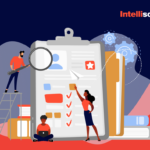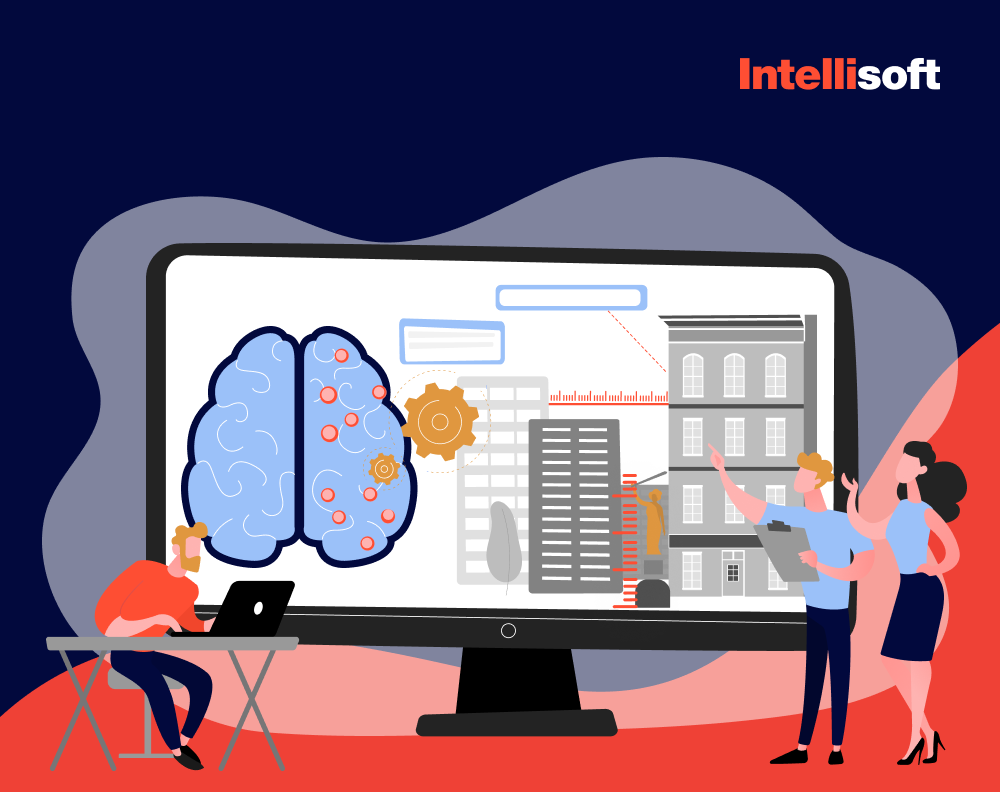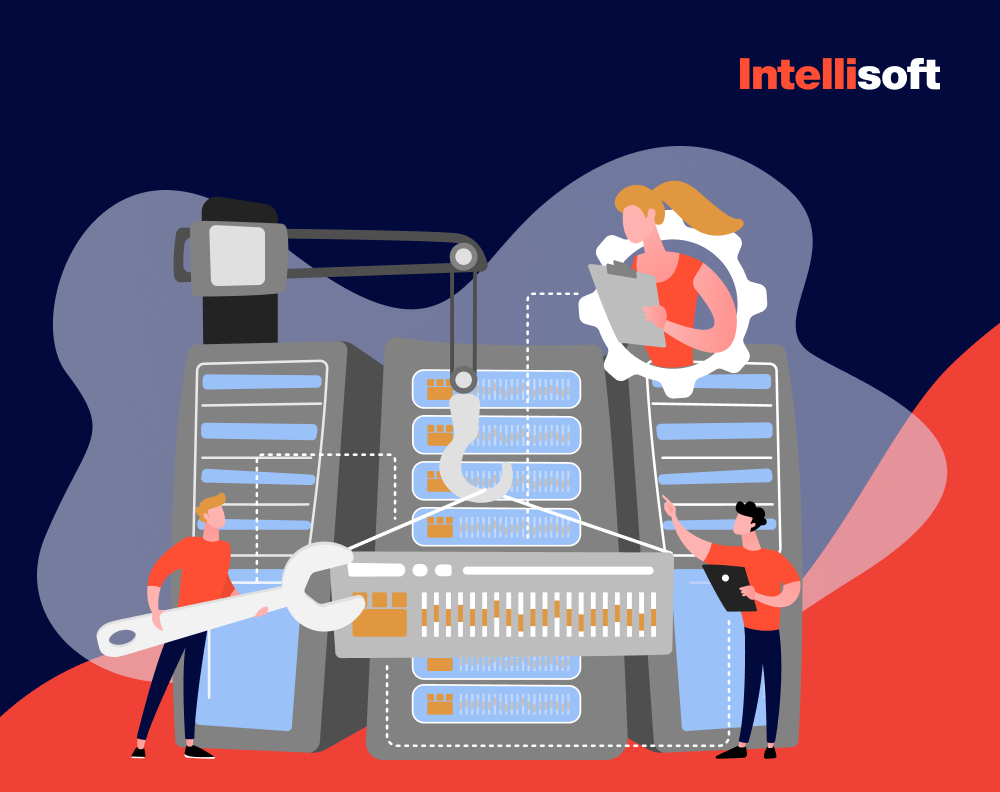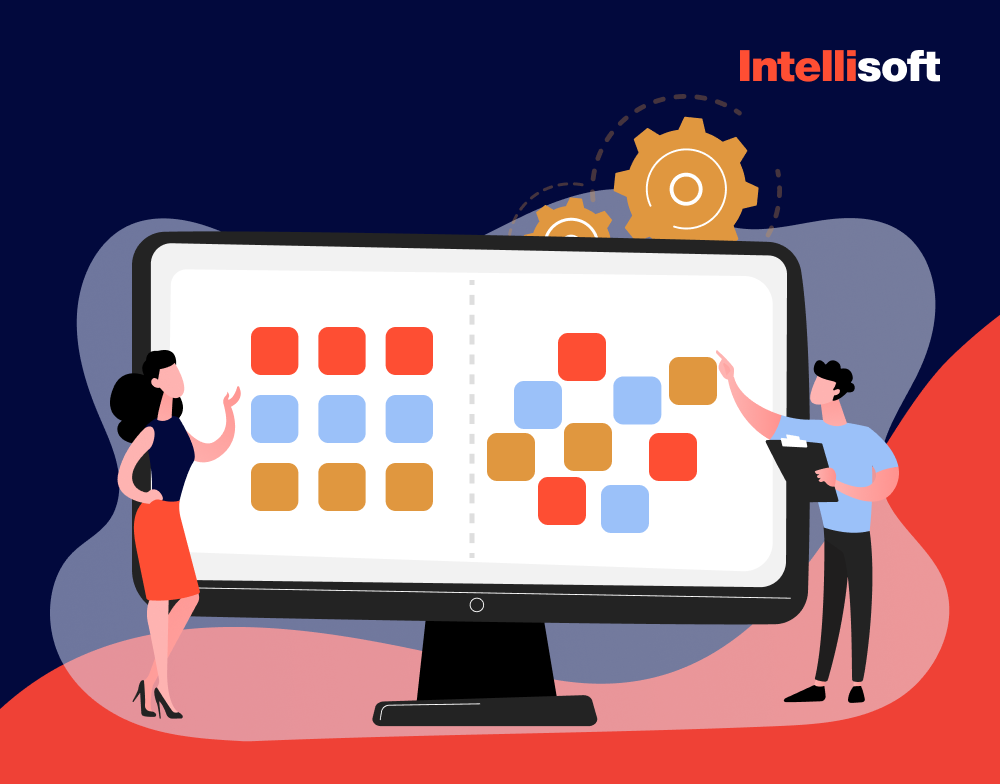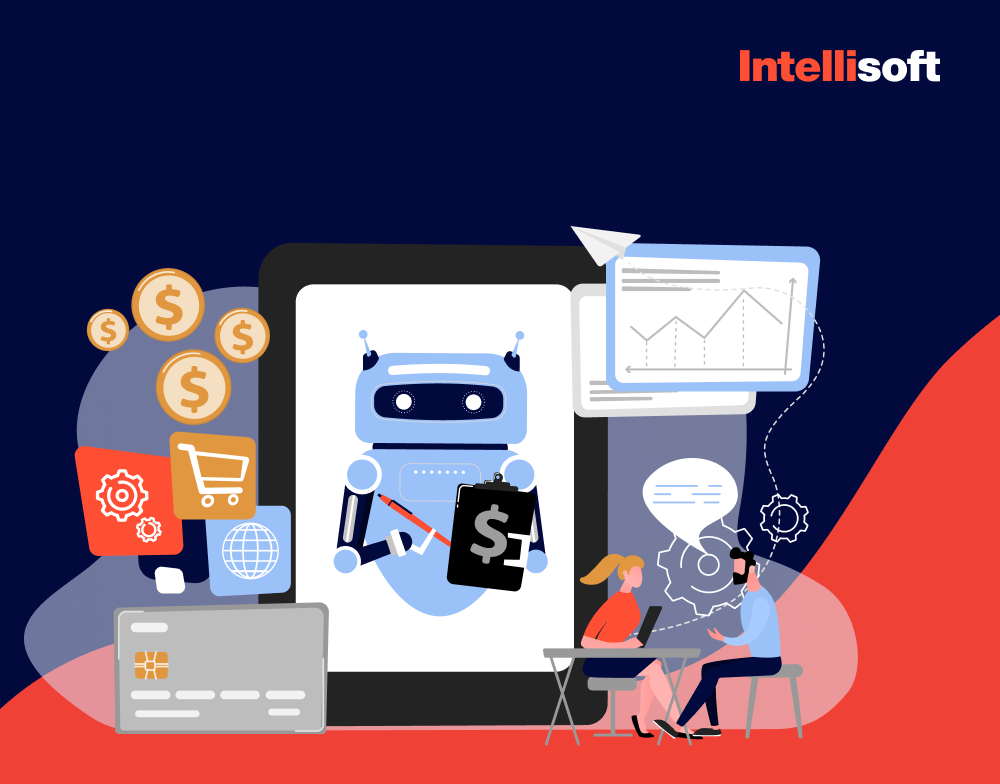Workforce forecasting is a strategic tool that aligns future staffing with business goals, ensuring companies stay current with market trends and new technologies. This forward-thinking approach is vital for maintaining competitiveness in the dynamic tech industry, guaranteeing that businesses have the right talent for upcoming projects and market changes.
For engineering managers, excelling in workforce management forecasting can significantly impact success. It involves more than just filling roles; it’s about predicting changes and outpacing competitors. By mastering workforce forecasting, managers can ensure their teams are agile, capable of overcoming challenges, and ready to capitalize on new opportunities.
In this article, we’ll delve into the essentials of workforce forecasting, examining how tech companies use this strategy to remain competitive and the major benefits it offers.
As the Personal Development Industry founder Paul J. Meyer, once said: “Productivity is never an accident. It is always the result of a commitment to excellence, intelligent planning, and focused effort.” –
Table of Contents
How Workforce Forecasting Works
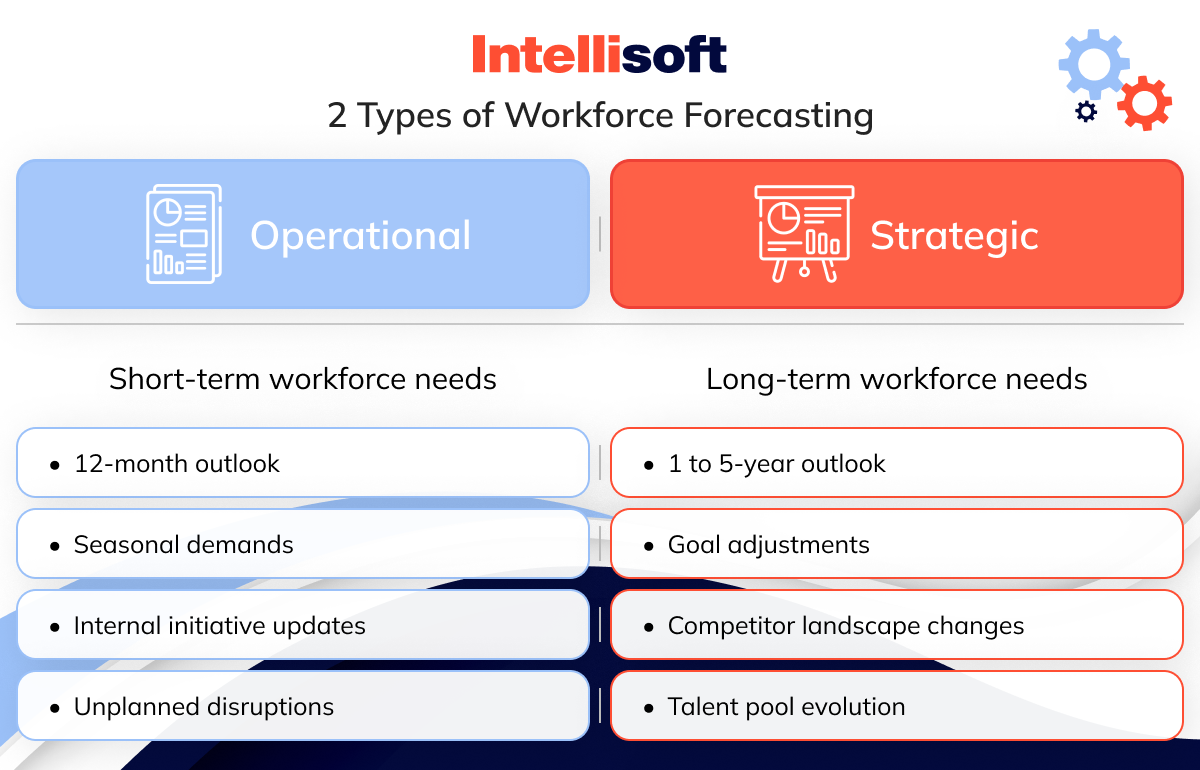
Workforce forecasting is a crucial strategy that leverages historical staffing data alongside future projections to predict personnel needs. This approach, when combined with key workforce metrics, allows businesses to optimize their operations for peak efficiency.
Workforce forecasting can be categorized into two main types:
- Operational workforce forecasting. This approach focuses on short-term organizational needs, usually within a 12-month period. It addresses immediate demands like seasonal peaks, updates to internal projects, and unforeseen disruptions.
- Strategic workforce forecasting. This method takes a broader perspective, covering a span of one to five years. It aims to align staffing with internal goals, adapt to changes in the competitive landscape, and evolve with the talent market.
Both types aim to answer essential questions affecting an organization’s ability to undertake new projects, reassign tasks efficiently, and ensure workforce changes align with strategic goals. Questions addressed include:
- Can we handle new projects with our current resources?
- Where can we reallocate tasks most effectively?
- What impact will workforce changes have on our strategy?
- Are any teams overburdened?
- Should we diversify our talent pool?
By tackling these questions, organizations can preemptively address potential skill shortages and staffing challenges. Using a workforce planning and forecasting template aids in effectively mapping out changes in talent and staffing needs, ensuring both current and future requirements align with broader business goals. This proactive strategy facilitates workforce management and boosts overall business agility and resilience.
Operational Forecasting Example
As the customer service manager at a retail store, you’re at the forefront of handling the ebb and flow of shopper traffic, especially with the holiday rush approaching. It’s vital to adjust your team’s schedules to manage the influx of customers hunting for the perfect gifts. However, once the festive excitement dies down, the challenge becomes scaling back, ensuring your staffing aligns with the quieter periods to maintain smooth operations and cost efficiency.
This is where operational workforce management forecasting works its magic. This proactive tool helps you adjust schedules and make informed hiring decisions just in time for the busy season, ensuring you’re never caught off guard. These forecasts go beyond mere numbers; they enhance your employees’ daily experience and protect your bottom line. By mastering operational forecasting, you ensure your team is always prepared for any surprises and foster a dynamic environment that thrives on readiness and responsiveness.
Strategic Forecasting Example
Imagine being in the middle of a busy call center, fielding one customer call after another. Even with top-notch customer service skills, long wait times can push even the most patient callers to their limits, especially when there’s a staff shortage.
But what if there’s a solution that keeps both customers and employees happy? That’s where workforce forecasting steps in, transforming how businesses manage peak hours. By analyzing call patterns, companies can adjust staffing levels to ensure just the right number of agents are available to help. The result? Happy customers, satisfied employees, and no unnecessary overtime. It’s a win-win, creating a balanced call center where customer satisfaction thrives, and everyone leaves with a smile. Quite a shift, right?
Why Is a Workforce Forecast Critical in Tech?
Aligning your team with project requirements isn’t just important—it’s vital. The industry is in constant flux, often undergoing overnight transformations thanks to innovations in machine learning and artificial intelligence. These advancements don’t just alter the rules; they redefine the entire arena, necessitating a new class of experts and a flexible approach to workforce planning.
However, attracting top-tier talent in this fiercely competitive market is no easy task. The most proficient professionals, equipped with cutting-edge tech skills and deep experience, are highly sought after. This intense competition significantly narrows the talent pool, especially for experienced developers. Therefore, strategic workforce forecast in tech becomes indispensable. It enables tech companies to predict changes, refine their recruitment strategies, and build a talent pipeline poised to tackle the tech world’s future challenges.
Benefits of Workforce Forecasting
Workforce forecasting may initially be intricate, but it revolutionizes both customer satisfaction and employee experience. Here are eight powerful benefits that underscore the significant impact of strategic workforce planning forecasting.
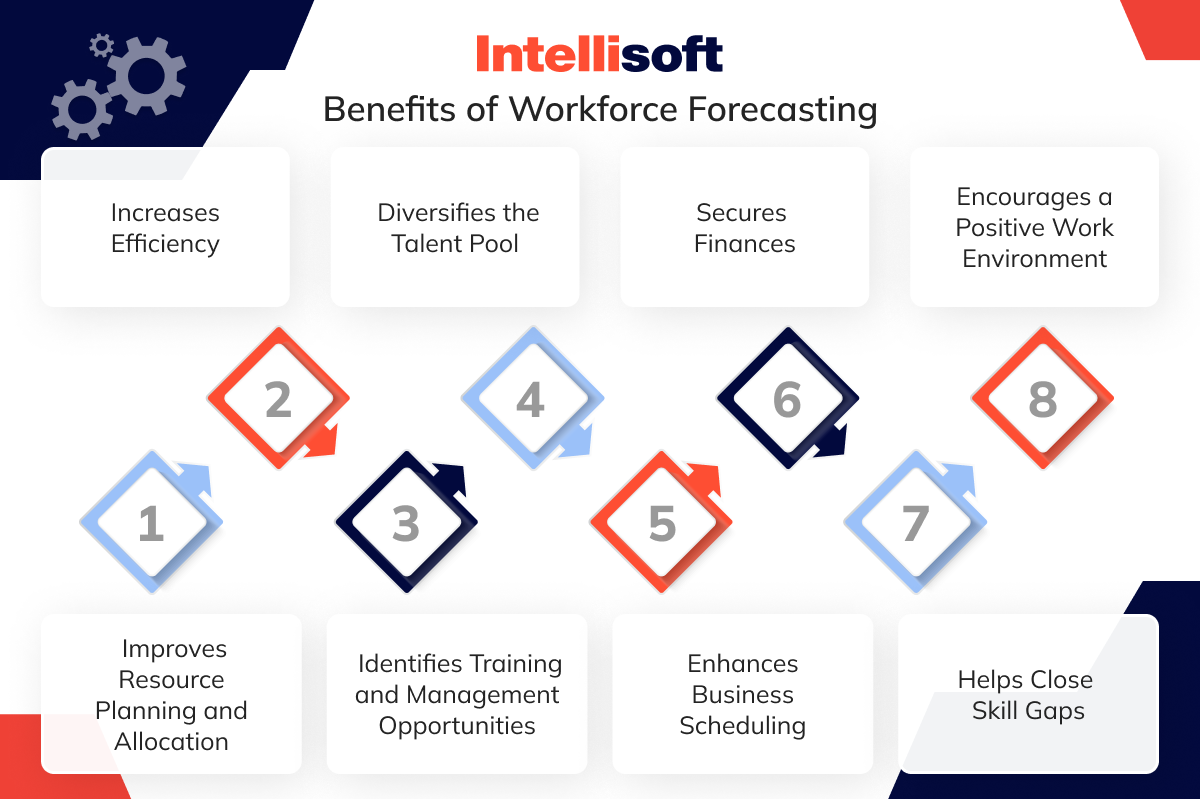
Improves Resource Planning and Allocation
Your team is your most valuable asset. By leveraging workforce forecasting, you can tap into historical market trends and data-driven insights to pinpoint your exact staffing requirements. This approach ensures you have the right people on board when you need them and also cuts down on costly staffing excesses, optimizing your budget and boosting efficiency.
Increases Efficiency
Forecasting reveals the peaks and valleys in an organization’s workload, allowing teams to detect skill shortages and scheduling issues before they arise, enhancing overall efficiency. When combined with strategic resource planning, workforce management forecasting helps fine-tune staffing schedules, adjust to shifting sales trends, and ensure employees are in the right place at the right time, ultimately saving money and streamlining operations.
Identifies Training and Management Opportunities
By tapping into workforce forecasting data, businesses can pinpoint exactly what training their employees need, be it developmental seminars or hands-on customer service workshops. This data not only reveals the perfect timing for staff to engage in their professional growth but also highlights the specific skills that need sharpening. Armed with this insight, you can strategically schedule training sessions and management courses to ensure your team stays ahead of the curve.
Diversifies the Talent Pool
Forecasting in workforce management goes beyond merely outlining staffing requirements; it opens up new avenues for diversification. This strategic approach identifies the precise skills your organization needs and guides hiring managers in making smarter recruitment and training decisions. Companies can promote workforce diversity by adopting innovative hiring and skill development practices for all employees. This approach, in turn, boosts product quality and innovation, ensuring that the team mirrors the diversity and dynamism of the market it serves.
Enhances Business Scheduling
Forecasting is a vital tool for optimizing your team’s workload. With strategic scheduling, teams are less likely to experience burnout or high turnover rates. Moreover, effective forecasting prevents issues of over or under-scheduling and limits excessive overtime, ensuring that everyone’s schedules remain balanced and manageable.
Secures Finances
Financial stability underpins the success of any thriving business, fostering sustainable growth and expansion. By mastering workforce forecasting, companies can optimize budgets and address financial challenges proactively, ensuring efficient resource allocation. When businesses prioritize integrating real-time data with historical insights into their budgeting strategies, they set the stage for achieving strong financial health.
Helps Close Skill Gaps
When a company experiences a growth surge or internal changes, accurate forecasting becomes a game-changer. It ensures teams stay agile and operations run smoothly. Picture a crucial team member leaving unexpectedly—thanks to previous training or smart reallocation of staff, the void is swiftly filled, preventing any disruption in workflow.
By leveraging both past data and future projections, organizations can identify potential gaps early on. This proactive strategy prepares them for future needs, making sure that an absence or a lack of specific skills doesn’t cause any setbacks.
Encourages a Positive Work Environment
Don’t underestimate the power of a great employee experience! A positive work environment not only boosts morale but also helps in predicting staffing needs and providing the right support. By incorporating AI into the employee experience, optimizing team schedules, and prioritizing work-life balance, you can greatly improve employee retention, satisfaction, and skill development. This strategy fosters a more fulfilled and capable workforce, ready to tackle any challenge that comes their way.
Related articles:
- How to Master an Enterprise Data Warehouse: a Complete Guide
- What is Data Visualization? Your Guide to Clarity
- Enterprise Data Management: Definition and Best Practices
- Predictive Analytics in Retail: Boosting ROI and Transforming Customer Experience
- Supercharge Decisions: A Business Intelligence Dashboard Guide
Key Components of Workforce Forecasting
Let’s look at three key components that form workforce forecasting.
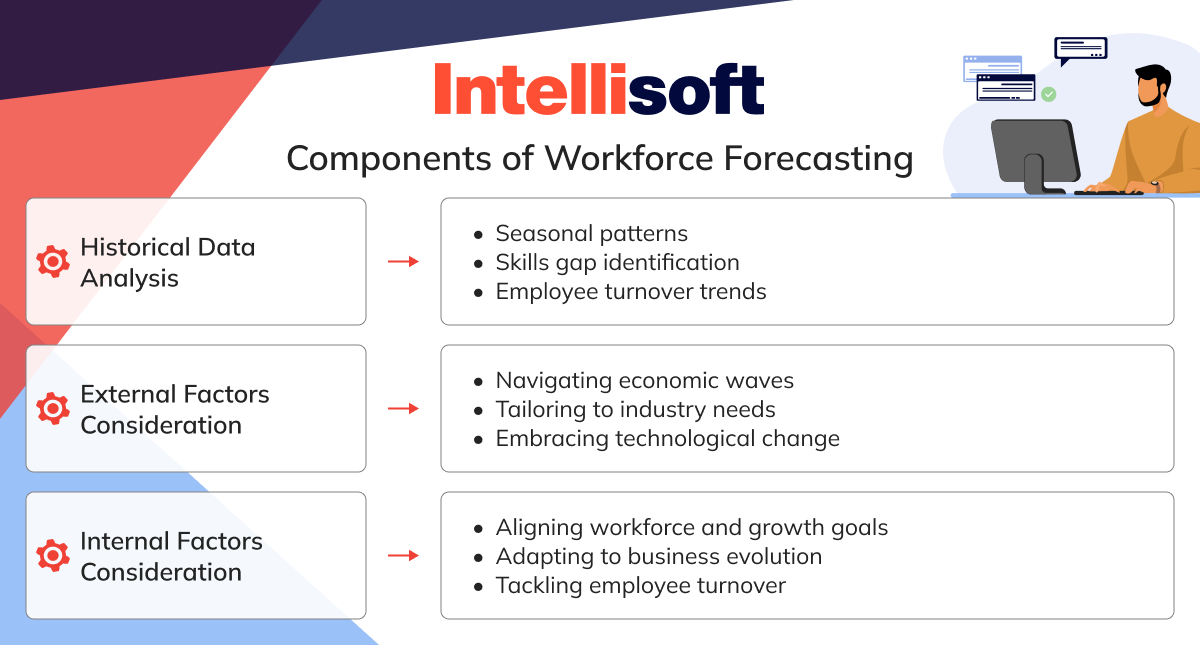
Historical Data Analysis
Exploring past workforce trends isn’t just about looking back—it’s about forecasting the future with precision. By analyzing historical data, companies unlock valuable insights into how they’ve managed their teams over time, observed seasonal shifts, and recognized recurring patterns.
Here’s how this deep dive into data can transform into strategic foresight:
- Seasonal patterns. By mapping the ebb and flow of workforce demands from the past, businesses can predict future needs. This approach means they can ramp up their staffing during busy times and scale back when things slow down, ensuring they operate at peak efficiency all year round.
- Skills gap identification. Ever wonder why certain projects didn’t quite hit the mark? Historical data sheds light on skill shortages that may have tripped up your team. Knowing this, companies can fill these gaps through targeted training, savvy recruitment, or smart reassignments.
- Employee turnover trends. Understanding why people have left in the past helps pinpoint what keeps them staying. This insight allows businesses to enhance employee engagement, tackle retention issues head-on, and cut down the costly cycle of hiring and training.
External Factors Consideration
There are also external factors that businesses should consider when building their workforce strategies:
- Navigating economic waves. Economic shifts significantly influence how companies plan their workforce. Monitoring indicators like GDP growth and unemployment rates help businesses adapt their strategies during economic booms and downturns, ensuring they stay resilient and competitive.
- Tailoring to industry needs. Each industry faces its own set of challenges and demands. Successful workforce planning hinges on a deep understanding of factors specific different industries, including technological innovations, regulatory shifts, and evolving market dynamics. These elements play a crucial role in shaping the workforce landscape and determining what skills are in demand.
- Embracing technological change. Technological advancements are reshaping industries at an unprecedented rate now. Companies that proactively adopt new technologies can leverage these changes for competitive advantage. Conversely, those who fail to keep up risk falling behind, facing significant skill shortages and outdated workforce structures.
Internal Factors Consideration
In addition to external factors, internal aspects are vital as well:
- Aligning workforce and growth goals. Effective workforce planning is crucial as your organization reaches for new heights—whether that’s breaking into fresh markets, exploring diverse product lines, or spearheading innovation. Forecasting your talent needs ensures you have the right people in place to turn your ambitious goals into reality.
- Adapting to business evolution. As your business landscape transforms, so do your operational needs. Workforce forecasting isn’t just about filling seats; it’s about understanding future shifts in your business processes and proactively adapting your staffing strategy to meet these new challenges head-on.
- Tackling employee turnover. High employee turnover can significantly stall progress. Organizations can develop effective retention strategies by anticipating turnover trends and uncovering the underlying causes. This method not only minimizes disruption but also fosters a stable, committed workforce that’s fully engaged in your company’s vision.
Tools and Techniques for Workforce Forecasting
In workforce planning, accurate predictions are the key to success. Companies blend human insight with data analysis, utilizing various workforce forecasting tools and techniques to effectively forecast future workforce needs.
This section delves into the diverse methods organizations employ. From data-driven quantitative approaches to intuitive qualitative workforce forecasting techniques, and even a blend of both, these strategies illuminate the path forward in the complex field of workforce forecasting.
Quantitative Methods
Let’s explain the main quantitative methods used in workforce planning:
- Trend analysis. Picture being able to foresee the future of your workforce by examining its past. Trend analysis enables this by scrutinizing historical employment figures, employee demographics, and turnover rates. Organizations can detect consistent growth or decline patterns, which are essential for making informed decisions about future workforce needs.
- Regression analysis. Imagine regression analysis as a sleuth for your workforce data. It reveals hidden relationships between various factors affecting your staffing requirements. By examining how company growth, financial performance, and customer demand influence workforce deployment, regression analysis provides a clear, data-driven insight into these connections.
- Time series models. Think of workforce forecasting models as a crystal ball for your staffing needs. They analyze historical data over time to uncover trends, cycles, and seasonal patterns. This method highlights regular patterns and accounts for unusual events that could impact future staffing needs, enabling more precise organizational planning.
Qualitative Methods
There are also qualitative methods to plan the workforce:
Expert opinions and the Delphi Method
Human expertise is indispensable in workforce forecasting. Gathering insights from senior leaders, managers, and subject-matter experts provides qualitative perspectives that pure data might overlook. The Delphi Method, a structured process for expert consultation, refines these insights into unified forecasts, ensuring a well-rounded view of the future.
Scenario planning
With the future full of uncertainties, scenario planning becomes a crucial tool. By creating multiple future scenarios based on various assumptions, organizations can envision a spectrum of potential workforce needs. This approach helps them stay agile and ready to adapt, no matter which scenario comes to pass.
Simulation and sensitivity analysis
Simulation techniques enable organizations to model different workforce scenarios and evaluate the impact of various factors. Sensitivity analysis enhances this by testing how changes in variables—such as turnover rates or business growth—affect the forecast. This combination provides a dynamic and detailed view of potential future challenges and opportunities.
Hybrid Approaches
Blending precise data with human insights creates a potent mix that sharpens workforce predictions.
- Demand-driven hybrid. Retailers excel at this by integrating historical sales data with the insights of their sales and store managers. This synergy allows them to forecast staffing needs more precisely, considering upcoming promotions and changes in customer behavior.
- Technology-infused hybrid. In the tech industry, merging trend analysis with expert opinions from industry leaders informs workforce planning. This method ensures that emerging technologies and necessary skills are seamlessly incorporated into future hiring plans.
- Market expansion hybrid. Companies entering new markets often employ scenario planning alongside regression analysis of previous market entries. This hybrid approach helps pinpoint potential workforce gaps and develop strategies to address them effectively.
Steps to Workforce Forecasting
Effectively forecasting your software development team is key to keeping projects on track and running efficiently:
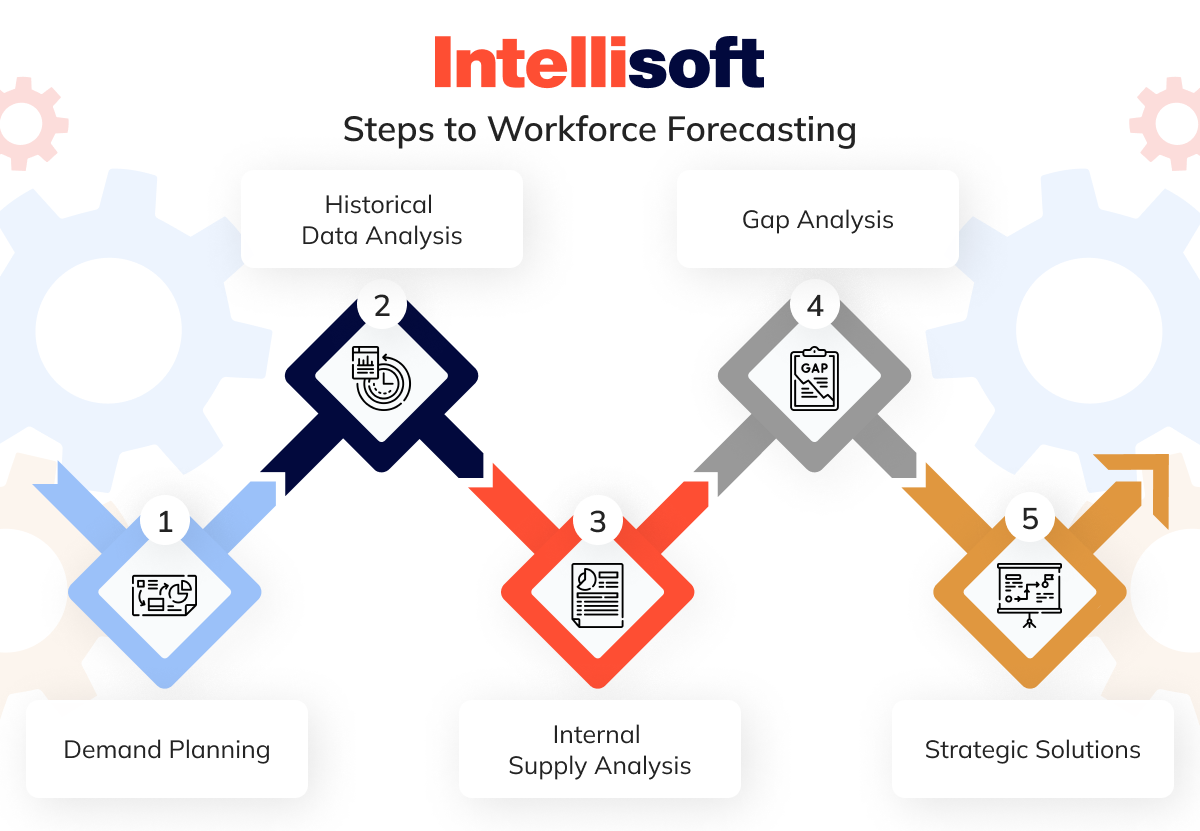
Demand Planning
Start by estimating your future staffing needs. Use ongoing and upcoming projects to determine the roles and expertise required to meet your objectives.
Historical Data Analysis
Examine past project data to reveal trends and patterns. This retrospective analysis provides crucial insights that help you better predict future requirements.
Internal Supply Analysis
Evaluate your current team’s skills and availability. It’s vital to assess if your existing workforce can handle the upcoming demands.
Gap Analysis
Identify any discrepancies between your team’s current capabilities and what will be needed. This step is essential for identifying potential skill or personnel shortfalls.
Strategic Solutions
Once gaps are identified, take action. Implement strategies like hiring, training, or adjusting timelines. These measures ensure your team stays flexible and ready for any challenges ahead.
Factors to Consider in Strategic Workforce Forecasting
When it comes to strategic workforce forecasting, companies in the tech industry use a variety of metrics to stay ahead. Understanding these key factors helps predict future staffing requirements and keeps a company competitive. Let’s dive into the essential elements of workforce forecasting and scheduling:
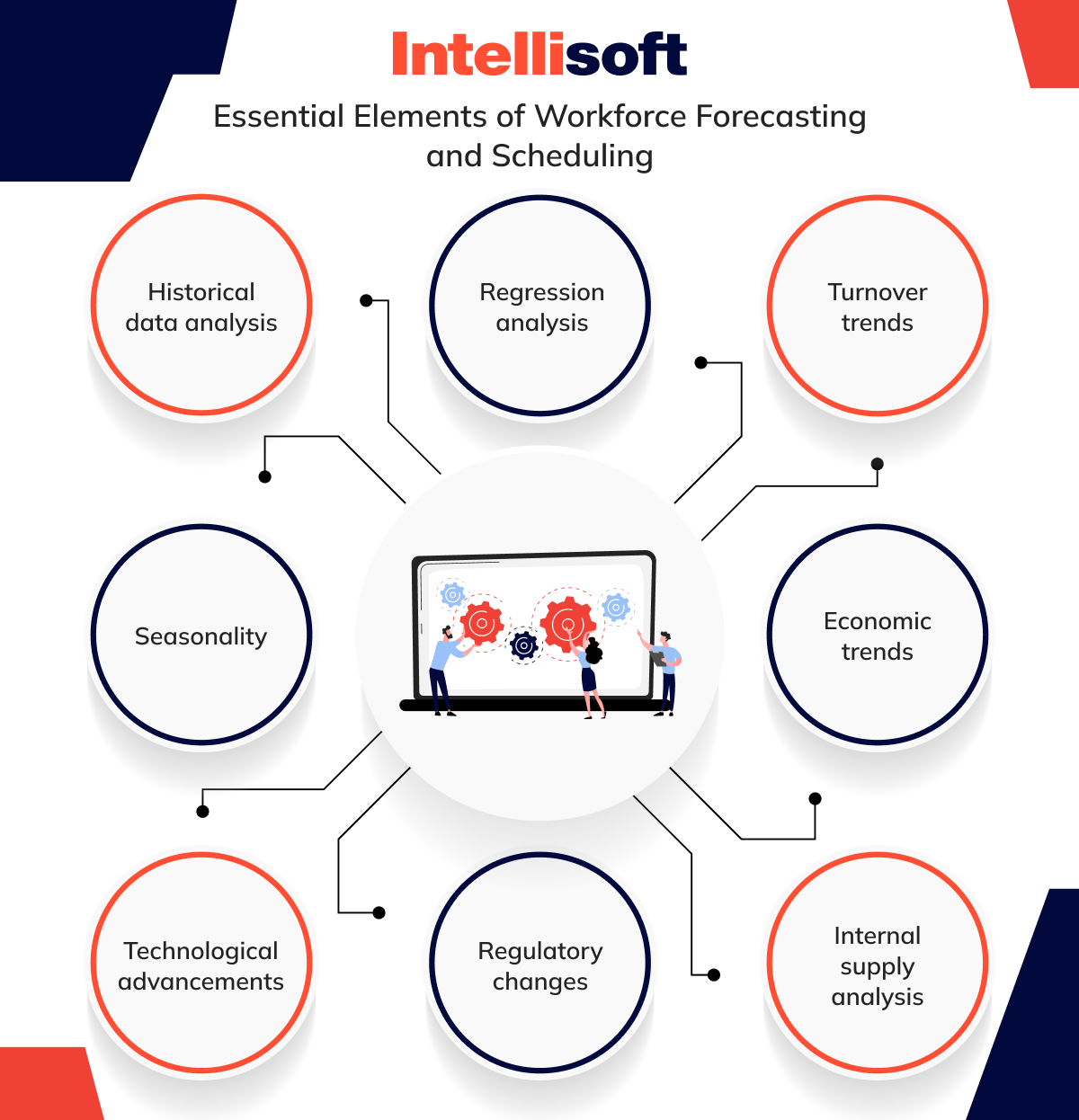
- Historical data analysis. This is the bedrock of workforce forecasting. By examining past trends such as remote working habits, automation, and employee satisfaction, organizations can forecast future staffing needs more accurately.
- Regression analysis. This statistical method explores the relationship between variables. In workforce planning, it helps predict how factors such as industry demand or economic conditions will affect future staffing.
- Turnover trends. Analyzing employee retention data offers insights into future staffing needs. Understanding why employees leave can help companies improve their environment, reducing the need for frequent hiring and enhancing workforce stability.
- Seasonality. Though less obvious than in other sectors, seasonality influences tech industry staffing. For example, tech firms often schedule hiring around graduation seasons and align product launches or updates with specific times of the year.
- Economic trends. Broader economic conditions play a significant role in workforce planning. Whether the market is expanding or shrinking can dictate a company’s hiring strategies and talent management.
- Technological advancements. Innovations such as generative AI can reshape demand for certain skills and resource allocations. Staying updated with tech trends enables companies to adapt their workforce strategies effectively.
- Regulatory changes. New regulations can force significant adjustments in hiring and employment practices. For instance, updates in data security or environmental laws might necessitate hiring professionals with specific expertise.
- Internal supply analysis. This involves a deep dive into the existing staff’s skills and potential for growth. Tech companies use this analysis to pinpoint skill shortages and decide whether to hire more staff or upskill current employees. Workforce forecasting software is crucial in making this process more precise and efficient.
Challenges in Workforce Management Forecasting
Engineering managers in the tech sector face unique workforce management forecasting challenges due to the industry’s rapid pace. Projections that made sense yesterday often become outdated today, requiring managers to reassess their teams to identify new skill gaps continually.
As technology advances quickly, predicting the next set of in-demand skills becomes a complex task. Specializations in emerging fields can suddenly become highly sought after, forcing organizations to spend heavily to attract top talent. This urgency can strain budgets, diverting funds from other critical areas and complicating the already intricate process of workforce management forecasting. It’s a dynamic balancing act that demands sharp insight and adaptability.
Addressing Staffing Needs with IntelliSoft
Workforce management forecasting and scheduling transform team management by leveraging historical data and trends to predict future staffing needs accurately. This method ensures that organizations consistently operate at peak efficiency, not merely filling positions but enhancing productivity and cost-effectiveness by optimizing each team member’s skills and time.
IntelliSoft exemplifies this strategy in the software outsourcing industry. We have perfected workforce forecasting, ensuring our development teams are precisely scaled for any project complexity. This strategic foresight is more than just effective planning; it’s a competitive edge that enables us to deliver high-quality software solutions on time and within budget. Such proactive planning allows us to meet and frequently surpass client expectations. Contact us today to learn how we can help you address your staffing needs.

